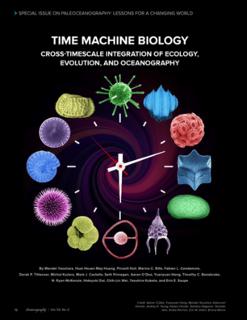Time machine biology : cross-timescale integration of ecology, evolution, and oceanography
Yasuhara, Moriaki; Huang, Huai-Hsuan May; Hull, Pincelli; Rillo, Marina C.; Condamine, Fabien L.; Tittensor, Derek P.; Kučera, Michal; Costello, Mark; Finnegan, Seth; O’Dea, Aaron; Hong, Yuanyuan; Bonebrake, Timothy C.; McKenzie, N. Ryan; Doi, Hideyuki; Wei, Chih-Lin; Kubota, Yasuhiro; Saupe, Erin E.
Peer reviewed, Journal article
Published version
Permanent lenke
https://hdl.handle.net/11250/2730854Utgivelsesdato
2020Metadata
Vis full innførselSamlinger
Originalversjon
Yasuhara, M., Huang, H.-H. M., Hull, P., Rillo, M. C., Condamine, F. L., Tittensor, D. P. ... Saupe, E. E. (2020). Time machine biology: cross-timescale integration of ecology, evolution, and oceanography. Oceanography, 33(2), 16-28. doi: 10.5670/oceanog.2020.225Sammendrag
Direct observations of marine ecosystems are inherently limited in their temporal scope. Yet, ongoing global anthropogenic change urgently requires improved understanding of long-term baselines, greater insight into the relationship between climate and biodiversity, and knowledge of the evolutionary consequences of our actions. Sediment cores can provide this understanding by linking data on the responses of marine biota to reconstructions of past environmental and climatic change. Given continuous sedimentation and robust age control, studies of sediment cores have the potential to constrain the state and dynamics of past climates and ecosystems on timescales of centuries to millions of years. Here, we review the development and recent advances in “ocean drilling paleobiology”—a synthetic science with potential to illuminate the interplay and relative importance of ecological and evolutionary factors during times of global change. Climate, specifically temperature, appears to control Cenozoic marine ecosystems on million-year, millennial, centennial, and anthropogenic timescales. Although certainly not the only factor controlling biodiversity dynamics, the effect size of temperature is large for both pelagic and deep-sea ecosystems.

